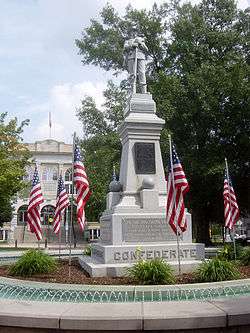James Henderson Berry
James Henderson Berry (May 15, 1841 – January 30, 1913) was a United States Senator and served as the 14th Governor of Arkansas.
James Henderson Berry | |
|---|---|
.jpg) | |
| 14th Governor of Arkansas | |
| In office January 13, 1883 – January 17, 1885 | |
| Preceded by | Thomas James Churchill |
| Succeeded by | Simon Pollard Hughes, Jr. |
| United States senator from Arkansas | |
| In office March 20, 1885 – March 3, 1907 | |
| Preceded by | Augustus H. Garland |
| Succeeded by | Jeff Davis |
| Speaker of the Arkansas House of Representatives | |
| In office 1873 | |
| Preceded by | Charles W. Tankersley |
| Succeeded by | A. A. Pennington |
| Member of the Arkansas House of Representatives | |
| In office 1866–1874 | |
| Personal details | |
| Born | May 15, 1841 Jackson County, Alabama, U.S. |
| Died | January 30, 1913 (aged 71) Bentonville, Arkansas, U.S. |
| Political party | Democratic |
| Profession | Lawyer |
| Military service | |
| Allegiance | |
| Branch/service | |
| Unit | 16th Arkansas Infantry |
| Battles/wars | American Civil War |
Early life

James Henderson Berry was born in Jackson County, Alabama, to Isabella Jane (née Orr) and James McFerrin Berry. The family moved to Arkansas in 1848. Berry attended Berryville Academy in Berryville, Arkansas, for one year. The academy was named after his family.[1] Berry studied law and in 1866 was admitted to the Arkansas bar.
American Civil War
At the outbreak of the American Civil War, Berry joined the Confederate Army and was commissioned as a second lieutenant with the 16th Arkansas Infantry. Berry lost his right leg during the Battle of Second Corinth in northern Mississippi. After recuperating from his wound, he worked as a school teacher and started a private law practice.
Political career
Berry was elected to the Arkansas House of Representatives in 1866. He was reelected in 1872 and in 1874. In his last term he was selected to be Speaker of the House. Berry was the chairman of the Democratic State Convention in 1876. In 1878 he became a judge for the Fourth Circuit Court and served in that post until 1882 when he was elected Governor of Arkansas. The Berry administration focused on reducing the state debt and creating a state mental hospital. Berry did not run for reelection. In March 1885, Berry was selected by the legislature to fill the unexpired term of Senator Augustus H. Garland. Berry remained in the U.S. Senate for the next 22 years.
Later life
In 1910, Berry accepted a position with the Arkansas History Commission to mark the graves of all Arkansas Confederate soldiers who had died in northern prisons.[2] Berry died in Bentonville, Arkansas, and is buried at the Knights of Pythias Cemetery (present-day Bentonville Cemetery), Bentonville, Arkansas.[3]
Personal life
In 1865, Berry married E.Q. "Lizzie" Quaile. They had six children.
References
- "History of Berryville". CarrollCountyAR.com. Retrieved August 17, 2012.
- "Arkansas Governor James Henderson Berry". National Governors Association. Retrieved August 17, 2012.
- "Former Senator J. H. Berry Dead". Arkansas Gazette. Bentonville. January 31, 1913. p. 1. Retrieved April 7, 2020 – via Newspapers.com.
External links
- United States Congress. "James Henderson Berry (id: B000418)". Biographical Directory of the United States Congress.
- Works by or about James Henderson Berry at Internet Archive
- Encyclopedia of Arkansas History & Culture entry: James Henderson Berry
- 1905 Full Portrait
- National Governors Association
| Party political offices | ||
|---|---|---|
| Preceded by Thomas James Churchill |
Democratic nominee for Governor of Arkansas 1882 |
Succeeded by Simon Pollard Hughes Jr. |
| Political offices | ||
| Preceded by Thomas James Churchill |
Governor of Arkansas 1883–1885 |
Succeeded by Simon Pollard Hughes, Jr. |
| U.S. Senate | ||
| Preceded by Augustus H. Garland |
U.S. senator (Class 2) from Arkansas 1885–1907 Served alongside: James K. Jones, James P. Clarke |
Succeeded by Jeff Davis |

